![]()
![]()
![]()
Use LEFT and RIGHT arrow keys to navigate between flashcards;
Use UP and DOWN arrow keys to flip the card;
H to show hint;
A reads text to speech;
37 Cards in this Set
- Front
- Back
|
What are the deep back muscles? I'd like to know the groups and each individual muscle in the groups
|
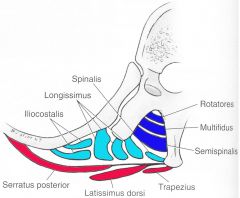
Erector Spinae Group: Spinalis, Longissimus, and Iliocostalis
From lateral to medial use alphabetical order: ILS Transversospinalis: Rotatores, Multifidus, Semispinalis |
|
|
What type of muscles are deep back muscles and what is their innervation?
|
Epaxial muscles innervated by dorsal rami
|
|
|
3rd layer of Extrinsic Deep Back Muscles: which two are there?
|
Serratus Posterior Superior and Serratus Posterior Anterior
|
|
|
Serratus Posterior Superior Muscle
|
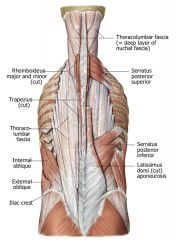
PA - Nuchal Ligament, spinous processes of C7-T3
DA - superior border of ribs 2-4 Action-elevates ribs: this occurs during inspiration BS- posterior intercostal arteries Innervation: VENTRAL RAMI OF Intercostal nerves of T2-T5 |
|
|
Serratus Posterior Inferior Muscle
|
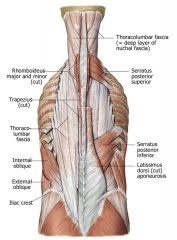
PA: Spinous Processes of T11-L2 vertebrae
DA: Inferior border of ribs 8-12 (near rib angles) Action: depress ribs: this action occurs when you expire air (exhale) BS: Posterior Intercostal Arteries Innervation: Ventral Rami of T9-T11 intercostal nerves and of subcostal nerve T12 |
|
|
Superficial Layer of Intrinsic Back Muscles: which muscles?
|
Erector Spinae Muscles, Splenius cervicis, and Splenius Capitis
Capitis is medial to cervicis and bigger as well |
|
|
Splenius Cervicis Muscle
|
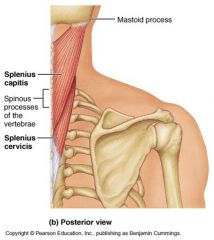
Origin: Nuchal ligament and spinous process T1-T6
Insertion: tubercles of transverse processes of C1-C4 Action: bilaterally will extend the head and neck and unilaterally will laterally flex neck and rotate head to side of contraction BS: Muscular branches of aorta and transverse cervical artery and occipital artery innervation: Dorsal Rami of Spinal Nerves |
|
|
Splenius Capitis Muscle
|
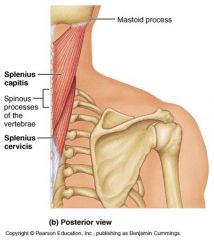
Origin: Nuchal ligaments and spinous processes T1-6
Insertion: Lateral parts of mastoid process and superior nuchal line Action: bilaterally will extend head and neck and unilaterally will laterally flex neck and rotate head to the side of the contracting muscle BS: muscular branches of aorta, transverse cervical artery, and occipital artery Innervation: dorsal rami of spinal nerves |
|
|
Iliocostalis Muscle
|
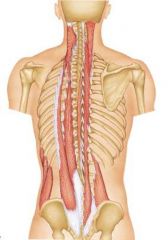
Most lateral portion of Erector Spinae Group
Origin: broad common tendon attaching to illiac crest, posterior aspect of sacrum, sacroiliac ligaments, sacral and inferior lumbar spinous processes, and supraspinous ligament Insertions: don't need to know but: lumborum: ribs 6-12 thoracis: ribs 1-6 cervicis: ribs 1-6 and posterior tubercles of Transverse Process of cervical vertebra C4-C6 Action: Bilaterally will extend vertebral column and head and unilaterally will laterally flex the vertebral column to the side of the contracting muscle BS: posterior intercostal and lumbar arteries Innervation: Dorsal Rami of Spinal Nerves |
|
|
Longissimus Muscle
|
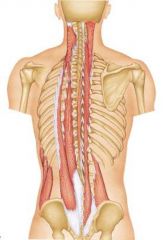
Origin of thoracis: broad common tendon attaching to illiac crest, posterior aspect of sacrum, sacroiliac ligaments, sacral and inferior lumbar spinous processes, and supraspinous ligament
Origin of Cervicis: transverse processes of cervical vertebrae C1-C6 Origin of Capitis: same as cervicis Insertion for thoracis: ribs 2-12 and adjacent TP of thoracic vertebrae Insertion for cervicis: TP of C2-C6 Insertion for capitis; mastoid processes Action: Bilaterally will extend vertebral column and head and unilaterally will laterally flex the vertebral column to the side of the contracting muscle BS to longissimus thoracis and cervicis: posterior intercostal arteries BS to longissimus capitis: occipital artery Innervation: Dorsal Rami of Spinal Nerves |
|
|
Spinalis Muscle
|
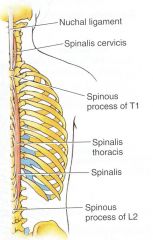
Origin of thoacis: spinous processes
Insertion: inserts on spinous processes superior to them Cervicis and Capitis: too difficult to ID BS: posterior intercostal arteries Innervation: Dorsal Rami of spinal nerves |
|
|
Deep Layer of Intrinsic Muscles of the back
|
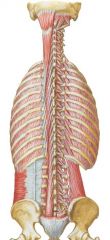
Transversospinalis Muscle Group: Semispinalis, rotatories, multifidus
All innervated by dorsal rami of spinal nerves |
|
|
Semispinalis Muscle
|
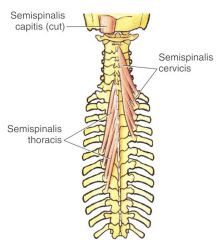
Cervicis: Cervical transverse processes to spinous processes of 2nd cervical vertebra
BS: Deep cervical artery Capitis:superficial to cervicis Comes from transverse processes of T1-T6 vertebra inserting into the nuchal line BS: deep cervical artery thoracis Comes from transverse to inserting into spinous processes in the thoracic region BS: posterior intercostal arteries Action: extend head, thoracic & cervical regions; rotates them contralaterally Innervation: Dorsal Rami of Spinal Nerves |
|
|
Semispinalis Capitis
|
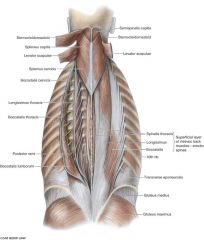
Semispinalis capitis is just deep to splenus capitis
|
|
|
Multifida Muscle
|
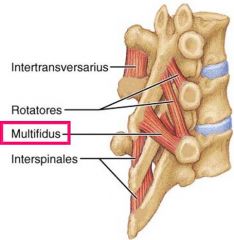
Covers lamina and spans segments from the sacrum up until C2
Origin: Transverse processes Inserts: inferior aspect of spinous process of the superior vertebra We will only look at this in the lumber region Action: stabilizes vertebrae during localized movement BS: posterior lumbar arteries Innervation: Dorsal Rami of Spinal Nerve |
|
|
Rotatores Muscle (brevis and longus)
|
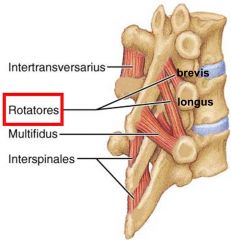
Brevis Origin: transverse process of one vertebra
Brevis Insertion: the base of spinous process on the vertebra superior to it. Longus Origin: Transerve processes of one vertebra Longus Insertion: Spinous process on the 2nd vertebrate superior (spans two intervertebral joints) Action: extend head, thoracic, and cervical region; rotates them contralaterally BS: posterior intercostal nerves Innervation: Dorsal Rami of Spinal Nerve |
|
|
interspinales muscle
|

Origin: spinal process and Inserts: to spinal process above it
Innervation: dorsal rami Action: muscle fiber component running with ligament: support BS: vertebral artery, occipital artery, posterior intercostal artery Innervation: Dorsal Rami of spinal Nerves |
|
|
Intertransversari Muscle
|
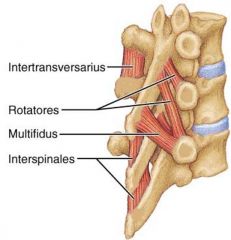
Origin: transverse process and Inserts: to the transverse process above it
Blood supply: deep cervical artery, vertebral artery, posterior intercostal artery Innervation: dorsal and VENTRAL RAMI of spinal nerves |
|
|
Levator Costarum Muscle
|
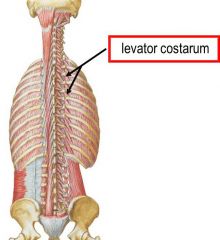
Origin : transverse process to
Insertion: the rib inferior to it Action: elevate ribs BS: posterior intercostal artery Innervation: dorsal rami C8-T11 spinal nerves |
|
|
Suboccipital Triangle
|
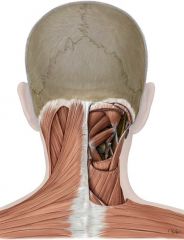
Made up of the Atlas and Axis and the muscles shown in the picture
Innervated by dorsal rami of spinal nerves |
|
|
Atlantooccipital joint and it's ligament
|
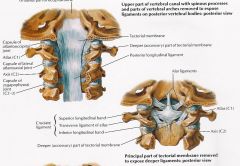
The joint that occurs between the occipital region and atlas
Is lined by the tectorial membrane at the location where the posterior longitudinal ligament crosses the atlas (the posterior longitudinal ligament becomes the tectorial membrane) |
|
|
Cruciate Ligament
|
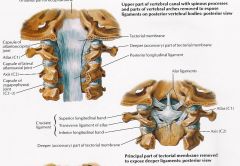
Ligament that is just deep to the tectorial membrane
Made up of three bands: Superior longitudinal band: goes up and down from the external occipital protuberance over the posterior most medial aspect of the atlantooccipital joint Transverse Ligament of atlas: goes over the atlantooccipital joint horizontally from left and right transverse process areas of the altantooccipital joints. Inferior longitudinal band: runs from the longitudinally atlantooccipital joint to the body of C2 |
|
|
Alar ligament
|
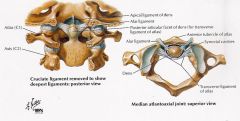
The deepest ligament
Ligament that is deep to the Cruciate Ligaments Alar ligament runs from the lateral aspect of the dens to the lateral aspects of the foramen magnum |
|
|
Transverse LIgament of Atlas
|
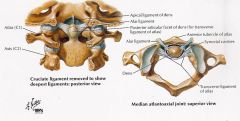
Runs transversely spanning the dens of the atlas transversely/horizontally
(can be seen in the median altantoaxial joint) |
|
|
Suboccipital Region Muscles: what are they and what do they do/provide?
|
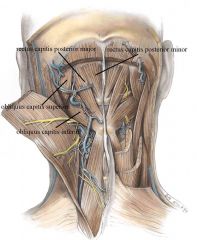
Rectus capitis posterior major
Rectus capitis posterior minor Obliquus capitis superior (superior oblique capitis) Obliquus capitis inferior (inferior oblique capitis) These are mainly postural muscles They can aid in extension and rotation at the altantoaxial joint BS: Vertebral artery and/or Occipital Artery Innervation: All innervated by dorsal rami of C1 (very first spinal nerve between occipital bone and atlas(c1)) |
|
|
Suboccipital Region Muscles: origin and attachments and innervation
|
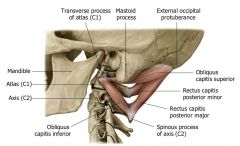
Rectus Capitis Posterior Major and Obliquus capitis inferior both originate from spinous process of C2
Rectus Capitis Posterior Major Inserts on the lateral inferior aspect of the inferior nuchal line Obiquus capitis inferior inserts to the Transverse process of C1 Obliquus Capitis Superior originates from the transverse process of C1 and inserts to the external occipital protuberance Rectus capitis posterior minor originates from the posterior tubercle of atlas C1 and inserts into inferior nuchal line All of these muscles are innervated by the Dorsal Ramus of C1 BS: Vertebral artery and/or Occipital Artery |
|
|
Contents of Suboccipital Triangle
|
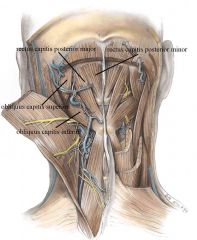
Suboccipital nerve and Occipital Artery
|
|
|
Nerves and Vessels in the Suboccipital Region
|
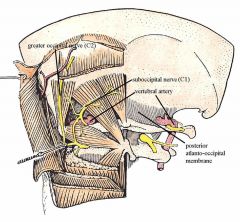
Vertebral Artery
Suboccipital Nerve-dorsal ramus of C1, between skull and atlas, motor innervation to all of the triangle muscles Greater occipital nerve-Dorsal Ramus of C2 between the atlas and axis-ONLY sensory fibers |
|
|
Occipital Neuralgia: what is it and how is it caused?
|
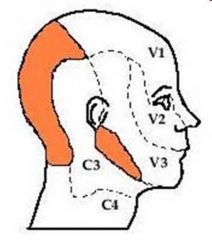
This is the irritation of greater occipital nerve (dorsal rami C2) and lesser occipital nerve (ventral rami C2)
Symptoms: neck pain that radiates upwards and around the sides of the head following the C2 dermatome |
|
|
Posterior Atlanto-occipital membrane
|
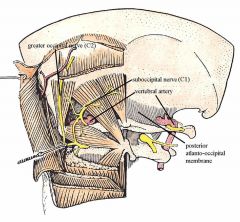
Posterior Atlanto-occipital membrane: the membrane that is continous with ligamentum flava
|
|
|
Cervical Trauma and Dislocations
|
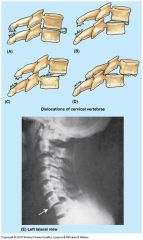
Cervical Vertebra are less interlocked and therefore can be dislocated the easiest (more prone to dislocation)
This can cause trauma to spinal cord and can present with spondoloythesis, with or without spondolysis |
|
|
Cervical Trauma of C1: burst fractures
|
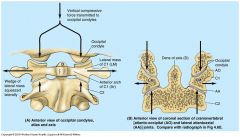
Jefferson Fracture/Burst Fracture: the lateral masses of C1 are compressed between occipital condyles and C2 which causes fractures on the anterior and/or posterior arches of C1.
Could also rupture transverse ligament of C1 Causes: Forceful compression of C1 (diving accidents, roll over car accidents, trauma compressing C1 downwards) |
|
|
Fracture/Dislocation of C2: Hangman's Fracture: what is it?
|
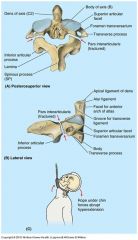
Fracture of the vertebral arch which is the fracture of the pars interarticularis (this is traumatic spondylolysis of C2
Caused by hyperextension of neck: hanging someone, severe cases of acceleration/deceleration syndome |
|
|
Cervical Trauma of Dens of C2
|

Fracture occurs at the base of the Dens
This fracture could also occur along the body of the axis just anteriorly to the dens Cause: horizontal blows to the head |
|
|
Soft Tissue Injury: Cervical Trauma
|
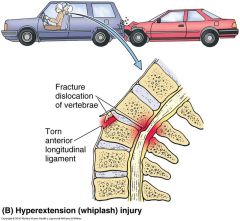
Acceleration/deceleration syndrome can cause this: forward and backward head snapping (rear ended collisions), Whiplashes can cause this
Damage to soft tissue, ligaments running along the vertebra. This will causes inflammation In severe cases, there may be bone fractures |
|
|
Vertebral Artery Impingement: what is it and what can cause it?
|
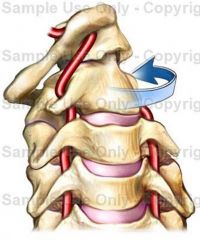
It is the sudden or forceful twisting of hyperextension or twisting of cervical vertebral column (mostly at Atlantoaxial joint)
This will impinge the arteries there and cause dizziness, vertigo, confusion, and nystagmus (uncontrolled jittery movement of eyes) |
|
|
Bow-Hunter's Syndrome
|

Cervical Vertigo, vertebral artery compression
Vertebral artery is blocked or narrowed when the head is turned. Causes: trauma, cervical spinal column abnormalities, degenerative diseases, arterial stenosis associated with cardiovascular disease Signs: dizziness, vertigo, confusion, nystagmus |

